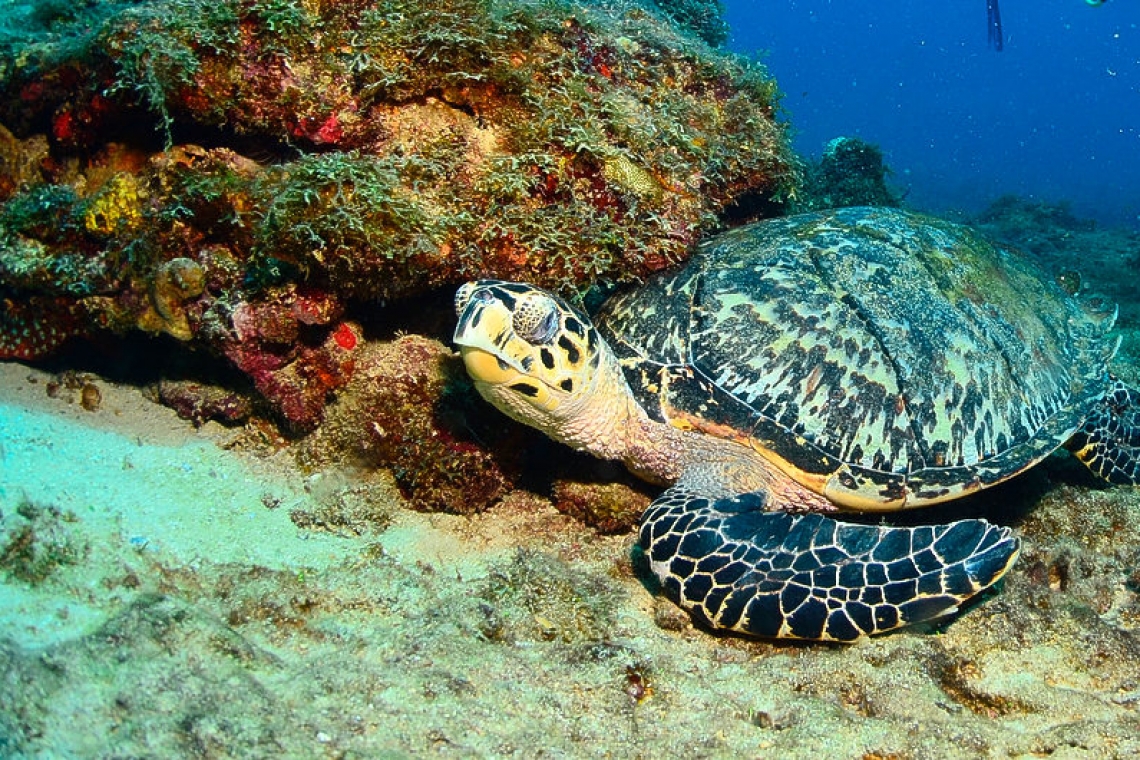A Hawksbill Sea Turtle (Photo credit: Leslie Hickerson)
Welcome back to Nature Foundation’s Sea Turtle Series for The KID’S Herald! This week, we will be covering the two most commonly spotted sea turtles on Sint Maarten, the Green Sea Turtle and the Hawksbill Sea Turtle.
Green Sea Turtles
These turtles actually get their name from the green colour of their body fat – this comes from their herbivorous diet of primarily sea grass! Green sea turtles can grow to be quite large, reaching over a metre long (that’s 3 to 4 feet)!
The largest green sea turtle recorded so far was 1.5 metres (5feet) in length and weighed almost 400kg (880lbs). These turtles are probably the most common in the waters of St. Maarten.
Here are some interesting facts about green sea turtles:
- These females do not nest as often as other species! Green sea turtles only nest every two to three years.
- When they do nest, females come ashore three to five times in one season and each nest can have up to 200 eggs!
- When resting, green sea turtles can stay underwater for two to three hours! They are able to preserve energy by lowering their heart rate and using the oxygen stored in their bodies.
- Do you know Crush, from the animated movies Finding Nemo and Finding Dory? He’s a Green Sea Turtle!
Hawksbill Sea Turtles
These turtles are easily identifiable due to the shape of their beak which is pointed and “hawk-like”. They are also known to have a beautiful and brightly coloured shell, which has led to them being hunted and used in “tortoiseshell” products.
Of all the species of sea turtles, the Hawksbill is at the highest level of threat, currently they are listed as Critically Endangered by The International Union for the Conservation of Nature (IUCN). This means that this species is facing an extremely high risk of becoming extinct in the wild.
There are several things that make Hawksbill sea turtles unique. Here are a few of our favourite facts about them:
- They are one of the smaller species of sea turtles. Hatchlings can be between one and two inches long.
- Adult Hawksbills can eat about 1,200lbs of sea sponge per year! Their diet can also include molluscs, algae, urchins, jellyfish and more.
- Females are very efficient out of the water with their nesting process only taking 45 minutes!
- The decline of coral reefs worldwide presents another risk to these turtles that rely on sponges as the primary part of their diet.
- These turtles can eat some animals and sponges that are toxic, but the Hawksbill’s fat absorbs the toxins without making the turtle ill.
Now that you know more about these amazing species how about some tips on what you can do to protect them?
- Never allow plastic to enter the ocean, especially plastic bags! Sometimes, sea turtles will mistake these for jellyfish and eat them, and that can result in injury or even death.
- Keep beaches dark and safe during nesting season (April – November).
- Make sure you and your family drive slowly while boating! There have already been three fatal boat strikes on turtles reported so far in 2020.
- Check out the next issue of The KID’S Herald to learn about two more species of turtles found in St. Maarten and how we can protect them!







